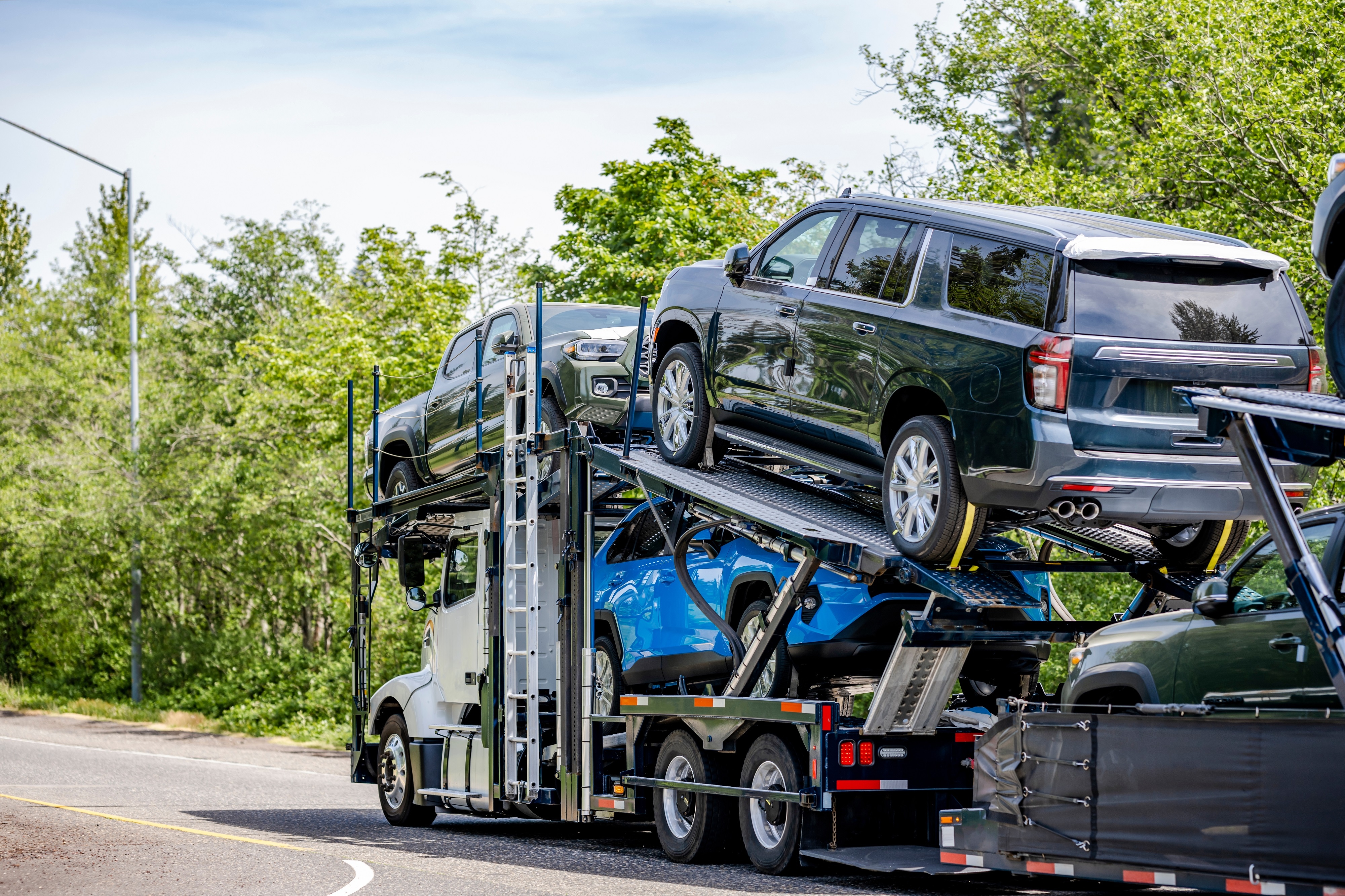Drivers may need to move a car from state to state for a myriad of reasons. Perhaps you’ve just sold a vehicle to an out-of-state buyer, and the purchaser can’t pick it up. Others may be moving to a new home. No matter your reasoning, moving a car from state to state requires thoughtfulness and consideration to facilitate a timely and damage-free delivery.
Your journey in state to state car shipping should begin with choosing a method to complete the job. The answer as to which method is the best depends on your vehicle transport needs and goals. Are you looking to save the most money? Maybe you’re prioritizing convenience or protective care to move a valuable classic.
The three most common ways to move a car across state lines are:
Doing it yourself
Hiring a professional driver
Shipping through an auto transport company or carrier
Let’s examine each method’s pros and cons in more detail so you can choose the option that’s best for you.
Moving a Car From State to State Yourself
Driving your car from state to state is the best way to save money on transport. If you’re planning to move your vehicle long-distance, turning your car’s transport into a road trip gives you the chance to explore. When looking to move your vehicle to a nearby state, a shorter journey can also make the prospect of self-transport worth considering.
However, moving a car from state to state yourself can present challenges, like encountering driving fatigue. You also need to consider the weather of your route. Someone driving cross-country during winter will benefit from taking a southern route, while others may be forced to drive through areas that are hazardous for those without cold-weather driving experience.
Additionally, driving your vehicle from state to state adds wear and tear to your car, which you could avoid with methods like auto shipping via a carrier. Suppose you’re embarking on a long-distance drive to another state. In that case, you’ll want to get a maintenance tune-up and inspection on your vehicle to lower your chances of experiencing inconveniences like breakdowns.
Moving a Car From State to State With a Professional Driver
Hiring a professional driver to move your car to another state is different from working with an auto hauler since the driver will be behind the wheel, while a vehicle transport will load your car onto an open or enclosed carrier—typically along with several other automobiles.
The most significant drawback to hiring a professional driver is that the service is usually more expensive than an auto hauler.
You can hire a professional driver by searching online for companies to help connect you with drivers or browsing freelance listings. However, verifying a driver’s reputation can be more difficult, as they don’t face stringent transport requirements like auto transport companies. Some services may allow you to ride along for additional peace of mind.
You’ll also have to deal with wear and tear on your vehicle, similar to driving it yourself. Still, you’ll experience less fatigue, and the driver’s sole focus will be on transporting your car, whereas an auto hauler often carries several vehicles at once.
Moving a Car From State to State With an Auto Transport Company
Using an auto transport carrier is often the most common way to move a car from state to state, especially during instances like cross country car shipping. Many auto haulers offer open or enclosed transport options. An open carrier exposes your vehicle to outdoor elements during travel but costs less money, while an enclosed carrier shields your car. Most people select an open carrier when working with an auto transport carrier.
Verifying a hauling company’s reputation is vital since these organizations must have several active credentials, like a USDOT number. A USDOT number allows the Federal Motor Carrier Safety Administration (FMCSA) to monitor information, including but not limited to a carrier’s safety records and compliance reviews. These companies also face insurance requirements and typically offer add-on insurance protection packages.
While hiring an auto hauler to move your vehicle from state to state is often more expensive than driving it yourself, the average car shipping cost is lower than booking an individual driver.
However, depending on how you structure your trip, you can still spend more doing the job yourself. Working with a carrier company is often considered the best way to move your car to another state since you’re experiencing high levels of convenience for less money and worry than hiring a personal driver.
How to Prepare Your Car for Transport
The method you choose for moving your vehicle from state to state will directly impact the steps needed to prepare your car. Keep reading to learn distinct preparation measures associated with each method and any overlap between options.
Driving It Yourself
First, you’ll want to inspect and maintain your vehicle. The most thorough way to check your car is with a certified mechanic’s inspection. Mechanics at franchised dealership service centers and independent garages often offer a pre-trip inspection.
A pre-trip inspection verifies the condition and status of vital vehicle components such as:
Tires
Brakes
Battery
Fluids
Belts and hoses
Air filters
General safety equipment
Mechanics may also advertise pre-trip inspections as pre-trip checkups or road trip inspections. You’ll also want to have roadside assistance service contact info on hand or equipment to solve common issues yourself, like a tire jack for flat tire changes or jumper cables. Cleaning your car will help you achieve a comfortable journey, and planning your route, along with stops for instances like food or rest, will reduce road fatigue.
Hiring a Professional Driver
Aside from verifying that your vehicle is in proper working order, you’ll want to remove any valuables if you’re not riding along with the service provider to eliminate worries of theft or damage during transport. Even if you’re riding with the driver, you’ll still want to remove valuable or loose items since damage can occur during travel whether or not you’re present.
It’s essential to communicate any special requirements you may have for driving your car and clear instructions on the destination. Hiring a professional driver is supposed to offer convenience, and miscommunication on details like the destination is a surefire way to experience stress.
Hiring an Auto Transport Carrier
Suppose you’ve decided that hiring an auto transport hauler is the best option for moving your car from state to state. In this instance, you’ll want to clean your vehicle thoroughly and document its condition before loading it onto the company’s carrier. You’ll report your car’s status on the bill of lading document, which describes the vehicle’s condition during pickup and delivery.
Inspection Differences
You won’t need to prioritize getting a mechanic’s inspection of your car before working with an auto hauler since the vehicle won’t be functioning during transport. However, getting your car detailed can help you more accurately determine its condition before a drop-off to later reference during pickup. If you’re worried about your vehicle experiencing damage from transport hazards like road debris, opting for an enclosed carrier service can give you peace of mind.
Like driving your car to another state or hiring a professional driver, you’ll want to remove loose and/or valuable items before transport to avoid damage.
Additional carrier considerations
A carrier’s insurance doesn’t cover personal belongings, and many haulers have restrictions on stowing items due to weight restrictions. Adjusting your fuel level is helpful since extra fuel adds unnecessary weight, but you should leave ⅛-¼ of a tank to help drive to a nearby gas station after delivery. Other carrier requirements may include turning off your vehicle’s alarm, but even if it’s not mandatory, silencing alarms can save your battery in case the system activates during transport.
Tips for Choosing a Reliable Auto Transport Company
It’s essential to verify an auto carrier transport company’s transport record, insurance, and reliability since several carriers have less than stellar reputations. You can perform this research yourself or save time and energy by hiring an auto transport broker to vet one or more carriers.
Earlier, we discussed how the FMCSA requires carriers to have an active USDOT number. The FMCSA also gives carriers an MC number to signal that the company is an authority for transporting goods from state to state. An experienced auto transport broker will verify that one or more carriers you’re working with meet these requirements and have valid insurance.
Brokers also vet carriers using methods that include but aren’t limited to:
Technology solutions
Checking experience levels
Evaluating on-time performance data confirming reliability
Verifying CSA (Compliance, Safety, Accountability) program scores
Broker networks
If you’re moving your car from state to state over a longer route and/or your vehicle has a more remote destination, a reputable auto transport broker has the means to connect you with more than one carrier since some companies may not be able to complete a route.
Brokers can link you with multiple carriers using direct network relationships or posting requests on platforms like central dispatch.
Final Verdict: The Best Way to Move a Car From State to State
While the best way to move a car from state to state is subjective, most people, especially those transporting their car longer distances, opt for an auto carrier service since it’s easier to verify these companies’ reputations with a broker instead of vetting a service like a freelance driver, it costs less on average than an independent driver, and there are different ways to load your vehicle.
You can determine the best service solution by evaluating your timeline and scheduling needs, budget, car type, pickup and delivery locations, and protection priorities.



